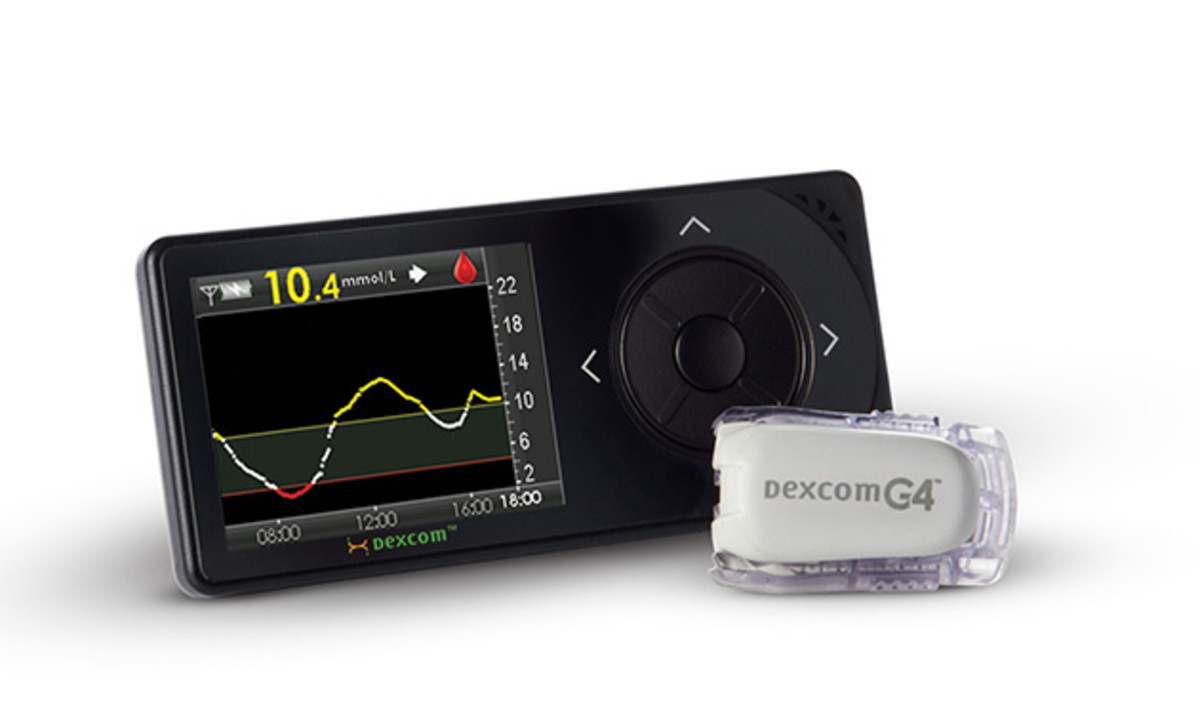Dexcom G4 monitors blood sugar in diabetics—and could aid athletes

The black cellphone-sized device buzzed intently three times. 80 mg/dL, the screen urgently warned in bright red letters on a black background, LOW. Time to take a sip of Gatorade.
The insistent messenger in question is the Dexcom G4 Platinum handset, a simple looking gadget that has made a big difference in the lives of many diabetics. One of a handful of continuous glucose monitors on the market, the G4 allows people suffering from type 1 mellitus—as many as three million Americans, according to JDRF, an organization that campaigns for research funding to cure type 1—to keep constant track of their blood sugar levels.
“A lot of times with the [glucose] meter I was more reactive,” says Haley Ganser, 31, who was diagnosed with type 1 diabetes when she was 15, and has been using a CGM since 2012. “I would feel that my blood sugars were dropping and so I would test myself. Now because I have the Dexcom I can actually see ‘OK, I’m at a fine level now, but it looks like I’m starting to drop, so I should probably eat a little snack now, before I start to feel the effects of the low blood sugar.’ So I can catch things faster.”
But diabetics aren’t the only people using the G4. Dexcom has sent units to the U.S. Olympic team, Red Bull’s High Performance Group, which runs experiments to determine the human limits of its endurance athletes, and even the Navy Seals. The U.S. women’s cycling track pursuit team at London 2012 credited its silver to an experimental data-driven training approach that included using a handful of Dexcom’s older SEVEN PLUS units.
***
When you eat food, carbohydrates are converted to glucose and absorbed into your blood. Cells in your pancreas called beta cells respond to this increase in blood glucose by producing a hormone called insulin, which stimulates your liver to convert and store this glucose as glycogen. When your blood glucose level drops due to exercise or between meals, another group of cells in your pancreas, alpha cells, produce glucagon, a hormone which has the opposite effect as insulin, making your liver convert glycogen back to glucose.
Krossover's game film solution keeps coaches out of the editing booth
The balance between the sugars you eat, energy you expend, and your body’s ability to produce and respond to insulin and glucagon dictates your blood glucose level. In type 1 diabetes, a person’s immune system attacks and destroys the beta cells, and as a result the body can no longer produce insulin. This means that after meals, blood sugar can shoot up to dangerously high levels. Artificial insulin is often used as medication to bring blood sugar back down, but if too much insulin in injected, the opposite problem can occur, resulting in dangerously low levels of blood sugar. And keeping track of glucose levels and how they are changing can be difficult.
Before using a CGM, “I didn’t always check whenever I was out exercising,” Ganser says, “I would try to check before, and maybe after, but I wouldn’t always carry my whole kit around, because it’s not very convenient to have my test strips and my meter and everything that comes along with doing fingersticks … out on a run.”
There are several cases of athletes who use Dexcom’s G4 to handle diabetes—including NASCAR driver Ryan Reed, U.S. Olympic cross-country skier Kris Freeman, snowboarder Sean Busby, and the Team Novo Nordisk cycling team—but even those not at medical risk from glucose highs and lows might be able to gain a significant edge from understanding their own nutrition needs better. Should they eat before exercise? What sports drink works best for them? When and how much should they drink? What is the best recovery snack? All of those details can vary between people, and from day to day, and perhaps the best way to answer those questions is to understand exactly what is going on inside.
***
Dexcom’s G4 system is made up of three pieces, a cellphone-sized handset, an inch-long wireless transmitter that sends data to that handset, and a disposable plastic component that sticks to the user’s body and inserts a fine wire under the skin. That wire is about the thickness of a human hair and extends about a quarter of an inch deep. Membranes coating the wire only allow glucose molecules to pass through to a layer where they react with chemicals to produce an electric current; by measuring that current the glucose level in the blood can be estimated.

Though the transmitter lasts for about six months, the plastic piece with the wire needs to be replaced every seven days. Partly this is due to the chemicals in the wire running out over time, but, according to Dexcom CTO Jorge Valdes, “the biggest limiting factor is actually your immune system. Having a wire under your skin is almost the same thing as getting a splinter.” Your body will start to encapsulate the wire, building a collagen shell around it to cut it off from surrounding tissue, and blocking its ability to measure glucose.
Now there is really only one way to understand how wearable tech works, and that is to wear it. With the G4 that presents a couple of challenges. The first is that it is a prescription-only device. Athletes get their hands on G4s because they have personal doctors willing to write them prescriptions—and because unlike medication, there really aren’t any side effects of using a CGM, so no real professional risk to the prescribing doctor. The second is that inserting a needle under your skin pushes the boundaries of how much most people might be willing to experiment on themselves.
Dexcom solved the first problem, and FedExed me a brand new G4. After a couple of days of making excuses to myself—I’m too busy today; maybe I should watch that online tutorial one more time; is this really a good idea?—I bit the bullet and solved the second.
The surprising part about using a CGM is how quickly you adjust. Inserting the device for the first time was weird, but relatively painless and I wouldn’t have a problem doing it again. Pricking my finger to test my blood and recalibrate the device every 12 hours was the same. In fact, the morning after I started using the G4 I was sitting in my local rowing club openly testing my glucose level before hitting the water.
Real Salt Lake seeking an edge by utilizing player-tracking technology
And the data is fascinating. Using a G4 is more addictive that Facebook. I found myself checking my blood glucose status more frequently than I picked up my smartphone. I learned that my blood sugar mostly hovers around 85 milligrams per deciliter, but jumps when I eat and drops noticeably at night. My first day using the G4 I showed up for an early morning indoor training session with my rowing team feeling exhausted, my blood glucose in the low 70s—I rarely eat before exercising. After an hour working out, I felt terrible. I had no energy and was breaking into the 50s.
So I went to Starbucks, had a coffee with sugar, oatmeal and a piece of banana bread. Slowly my glucose level picked back up and stabilized around 85. I felt well enough to go back to the boathouse and head out for a solo row on the San Francisco Bay. I took an energy drink and a granola bar with me to try and stay hydrated and energized, but the combination of my earlier low and now more exercise conspired against me. Each time I paused to take a sip my levels would start to improve, but each time I settled back into the row, the G4 would start buzzing again in warning. My blood glucose didn’t really stabilize until a full day later, after I forced myself to rest.

“Once you bonk in one of these events, your ability to recover from that is actually really hindered,” Valdes explains. “You reach one of those points where you let your blood sugar go into the hypo range—where it goes really low—you then end up taking a lot of carbs, so then you shoot up. Then the carbs wear out, and you shoot back down. And you end up in this zigzag thing of going back up and down.”
The lesson I learned, the value of correct nutrition and rest, is not exactly ground breaking, but seeing that spelled out in raw data on the G4 might be. In theory, with this sort of biofeedback, I could fine tune and personalize both my nutrition and exercise strategies to avoid spikes or troughs in blood sugar and keep my energy levels constant. For me, that might translate simply into greater enjoyment of exercise, but for a pro athlete that could be the difference between success and failure.
***
Dexcom’s system is not, yet, designed for non-diabetic athletes. The high and low warning alerts, the minimum and maximum blood sugar levels on the screen and the ability to record insulin doses are all designed for those suffering from diabetes. And the fact it is only FDA approved for prescription use means you won’t find the G4 sold in your local sports store anytime soon. Turning Dexcom’s CGM into a consumer athletics product would require a link up with an existing athletics company, and though Valdes admits that he has had talks with a handful of interested parties, he stresses that Dexcom’s focus is still the health rather than fitness market.
But the case of the G4 highlights a blurring of the lines between medical and fitness technologies. There are already fitness wearables that can measure your heart’s full electrocardiogram signal rather that just your heart rate, others that use electromyography to record muscle activity, or use infrared light to measure muscle oxygenation. And there are other medical technologies on the fringe of crossing over, including wireless pills that measure core body temperature and sensors that measure the hemoglobin level—the oxygen carrying capacity—of blood. The major medical advances that made the jump across to sports used to be drugs, but now they might be data.
